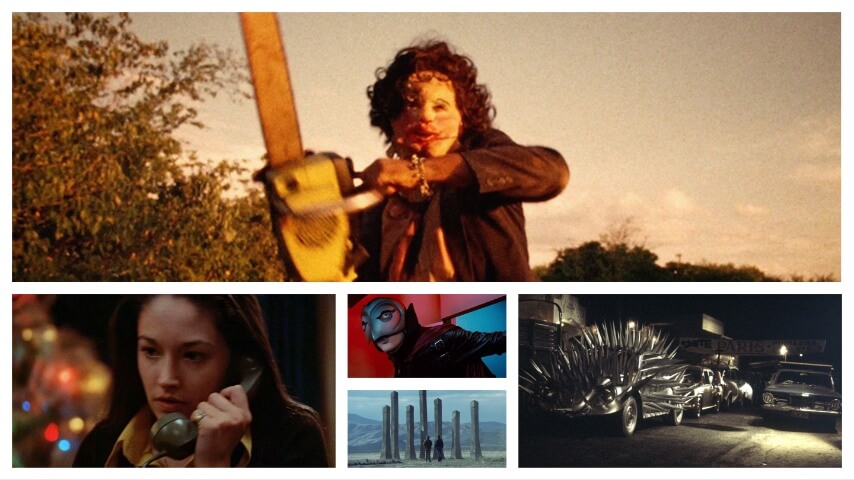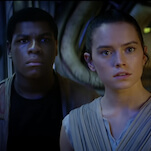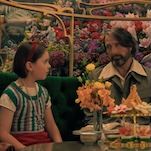Before George Miller was making apocalyptic car chase movies in Australia, there was filmmaker Peter Weir and his delightfully eccentric New Wave tale of a town consuming itself amid an economic crisis. Set in the title Australian town of Paris, the film follows a community that’s resorted to becoming a deadly chop shop to survive in harsh times, only to find that the very engines that keep the town running are about to chew it up. It’s a remarkable piece of social horror, but what keeps The Cars That Ate Paris running at top speed is the way Weir embraces the quirks of the narrative, from an unwitting victim of Paris forced to become part of its machinery, to a series of wild modified cars driven by local teenagers. It all culminates in a bloody romp, and remains one of the most influential Australian genre movies ever.
Deranged
While The Texas Chain Saw Massacre was certainly inspired in some ways by the exploits of American grave robber and murderer Ed Gein, Deranged flat-out lifts details of Gein’s life whole cloth and applies them to a horrific, relentless docudrama. Starring Roberts Blossom as the Gein-like Ezra Cobb, Deranged follows a simple farmer as the death of his mother leads him down a very dark path, beginning with desecration and progressing into all-out savagery. Like Chain Saw, with its opening narration promising a true tale of terror and verite shooting style, Deranged does its best to aim for a true-crime vibe, going so far as to insert a journalist narrator into the middle of scenes. But what makes it really work is the humanity Blossom brings to the role. He’s a monster, but we can see a certain twinkle in his eyes, a sense that he’s just a man who sees a path to fulfillment for himself. That’s both unnerving and frighteningly relatable.
From Beyond The Grave
Another Amicus release, From Beyond The Grave is the last of the company’s horror anthology films released throughout the early 1970s. Like all the other Amicus anthologies, From Beyond The Grave assembles a cast of British all-stars like Peter Cushing, David Warner, and Donald Pleasence, this time to tell a quartet of stories all centered on some version of greed. And like the other Amicus anthologies, it’s a simultaneously spooky and funny ride, giving us ghostly rooms tied to creepy antique doors, cursed mirrors, dark magic, and more. Though they’re not as well-remembered today as their TV counterparts like The Twilight Zone and Tales From The Crypt (the latter of which Amicus did a feature-length take on back in 1972), the Amicus anthologies made an impression on a generation of horror fans, and From Beyond The Grave in particular is a wonderful throwback to satisfying stories about unsavory people getting their just desserts.
It’s Alive
Cult movie purveyor Larry Cohen knew how to wring maximum enjoyment out of a single creature or gimmick, and his first horror film as a director is a prime example of that gift. All Cohen needed to make a rollicking, darkly funny, relentless little creature feature was a mutated monster baby, provided by FX legend Rick Baker, and a small budget to keep the cast and crew on that monster baby’s tail. It’s gruesome, unexpected, and filled with Cohen quirks that pick apart the creature feature subgenre even while participating in it, like when we get a rain not of blood, but of milk when the baby goes for the local dairy delivery service. It’s Alive influenced low-budget filmmakers across genres for decades, touching the work of everyone from John Landis to Damien Leone, and it’s still a blast to watch.
Lisa And The Devil
Italian Gothic maestro Mario Bava certainly made films that are more influential, and more essential, than Lisa And The Devil. He also made films that were less tampered with, as Lisa was eventually re-released with new scenes as The House Of Exorcism, a film Bava disowned. Its tumultuous release and its relatively low ranking among Bava’s classics aside, though, this film still has a lot to offer, and stands out as one of the filmmaker’s strangest horror entries. It’s the story of a tourist in Spain (Elke Sommer) who finds herself stranded at a manor house where a wicked butler (Telly Savalas, having a ball) might just be the Devil himself. It’s a story of past lives and present magic and some very strange romantic entanglements, and while it can be a bit hard to follow at times, there’s an impressionistic dread that follows every frame, and Bava’s legendary visual style is on point, making Lisa And The Devil more than just a curio for Bava completists.
Madhouse
The last 1974 Amicus film on our list (alphabetically, at least) might be the most purely entertaining. Starring Vincent Price as an out-of-work horror actor trying to make a comeback after a personal tragedy, Madhouse is a slasher whodunit, a Gothic mystery, a black comedy, and a showbiz movie all in one. Its setup gives Price a chance to play a horror villain in movies within the movie, donning now-iconic skeleton makeup to play “Dr. Death,” while also poking a bit of fun at his own reputation as the embodiment of spookiness in the mid-20th century. Throw in some wonderfully macabre death scenes and Amicus staple co-stars like the great Peter Cushing, and you’ve got an entertaining latter-day entry from two horror masters proving they’ve still got it.
Messiah Of Evil
One of the most overlooked horror films of the 1970s, Messiah Of Evil is finally getting its due thanks to its re-emergence in the streaming world, and it’s easy to see why. Willard Huyck and Gloria Katz’s film—about a woman (Marianna Hill) who goes searching for her father in a seaside town and finds dark forces at work—is dreamlike, chilling, and often downright harrowing. You can see its dramatic, haunting depiction of a coastal town dying under supernatural strain influencing everything from The Fog to The Lost Boys, and even today it feels like you’re watching a cursed object, a film so cloaked in darkness and strange energy that it might crawl right out of the screen and grab you. It’s one of those movies that ‘70s horror evangelists will demand you watch if you’ve never seen it, and they’re right.
People Toys
Better known by its re-release title, Devil Times Five, People Toys has been recommended by genre cinema devotee Quentin Tarantino, who highlighted it as an essential underseen gem of ’70s horror back in 2020. It’s a simple story, really: A family in a remote snowy lodge are attacked by a group of lost children with sociopathic, monstrous tendencies, led by child star Leif Garrett as their sociopathic ringleader. These kids set death traps, they tamper with cars, they do everything possible to make life a nightmare for the adults in the room, and it all builds to an absolutely chilling final scene that’ll leave you squirming. It might not have the reputation of other kid-centric horror like The Omen, but it’s often just as creepy, and deserves many more fans.
Phantom Of The Paradise
As much a comedy and a musical as it is a horror picture, Brian De Palma’s Phantom Of The Paradise stands alongside The Rocky Horror Picture Show as one of the essential cult films of their decade, and not just because they’re both over-the-top musicals inspired by horror fiction. Yes, De Palma and composer/co-star Paul Williams clearly relish their chance to mix Phantom Of The Opera with glam rock, but as a horror film, Phantom Of The Paradise also works as a dose of nightmarish, campy ghoulishness, from the Phantom’s unforgettable mask and makeup to the continued transformations of build-a-rock-star Beef, played with fierce commitment by Gerrit Graham.
Phase IV
The sole feature directed by legendary logo, poster, and title designer Saul Bass, Phase IV is a sci-fi horror film that takes its cues from classic insect attack movies that came before, then twists those influences into something much more bleak and horrifying. Through Bass’ lens, this story of ants banding together into a super-army via alien influence becomes a tense, atmospheric, often shockingly realistic piece of sci-fi horror, from the obelisk-like ant structures that function as antennas to the close-up photography that turns the tiny creatures into giants of terror without ever resorting to camp. It’s one of those films that’ll have you convinced there’s something crawling all over you for hours after you’ve watched it, and you can see it influence on a certain kind of scientific paranoia in films like John Carpenter’s The Thing, as well as its creeping terror in modern success like Sébastien Vaniček’s killer spider movie Infested.
Sugar Hill
Blaxploitation horror does not begin and end with Blacula, and for proof, we’ve got this 1974 revenge film about the title character (Marki Bey) setting out to destroy those who killed her club owner boyfriend with a blend of pure, uncut moxie and voodoo rituals. Basically, it’s a Blaxploitation vengeance quest with zombies thrown in for good measure, and Police Academy director Paul Maslansky makes excellent use of the genre crossover. The revenge element of the film works well, complete with all the requisite Blaxploitation dialogue, but it’s the zombies and their truly creepy look that complete the picture. It’s a thriller wrapped in cobwebs and crawling with the undead, and we might not have that legendary apartment building raid sequence in Dawn Of The Dead without it.
The Texas Chain Saw Massacre
Of course, one can’t complete a tour of 1974’s horrors without talking about the reason we’re here in the first place. Yes, The Texas Chain Saw Massacre is far and away the most well-known, beloved, and discussed film on this list. Yes, it’s been flooded with new tributes, but it still deserves more, because there’s something about this movie that can’t ever be replicated. In the way Hooper depicts the oppressive Texas heat, in the mad look in Marilyn Burns’ eyes, in the nightmarish sound design that might be coming from livestock or might be coming from the yawning pit of hell itself, it’s a singular motion picture that truly feels like something we’re not meant to be watching. Even five decades later, Tobe Hooper’s film still plays like a living nightmare, a thing that feels so real and urgent that it might as well be happening in your living room. It’s a masterpiece, an essential, and a gateway to many other great horror films that arrived in 1974.









































